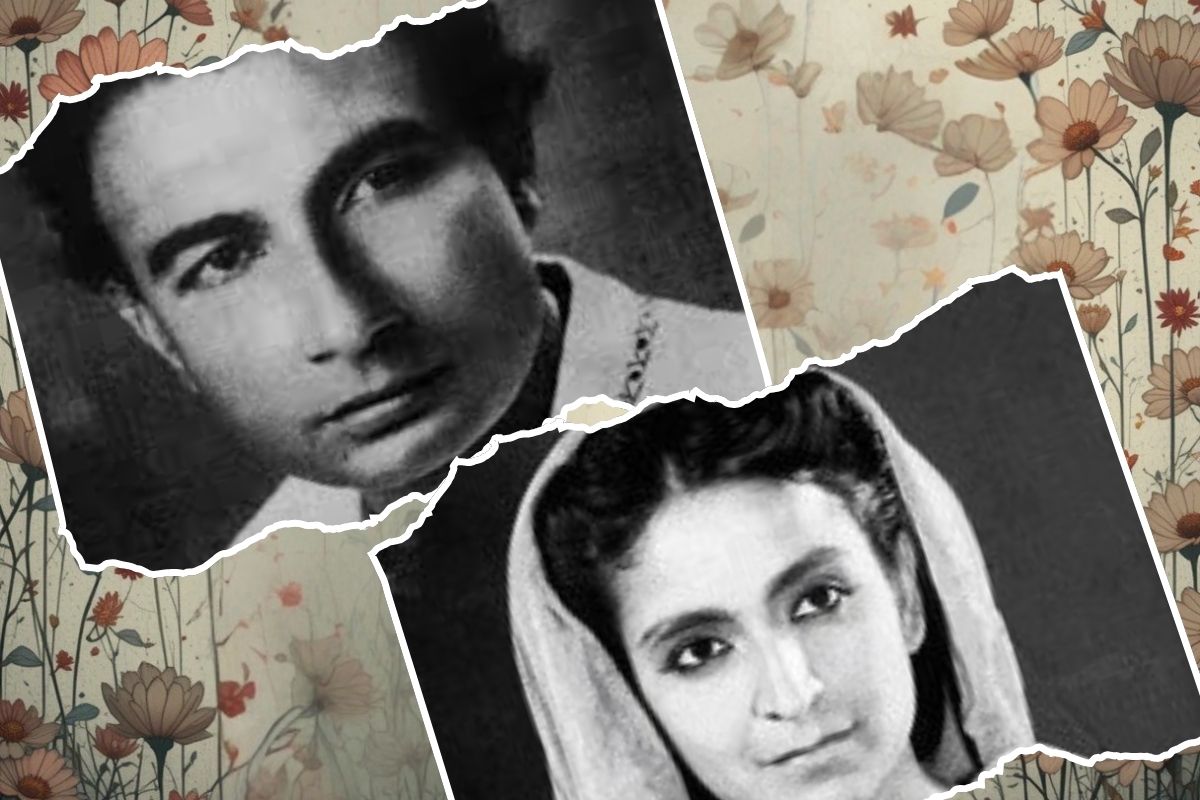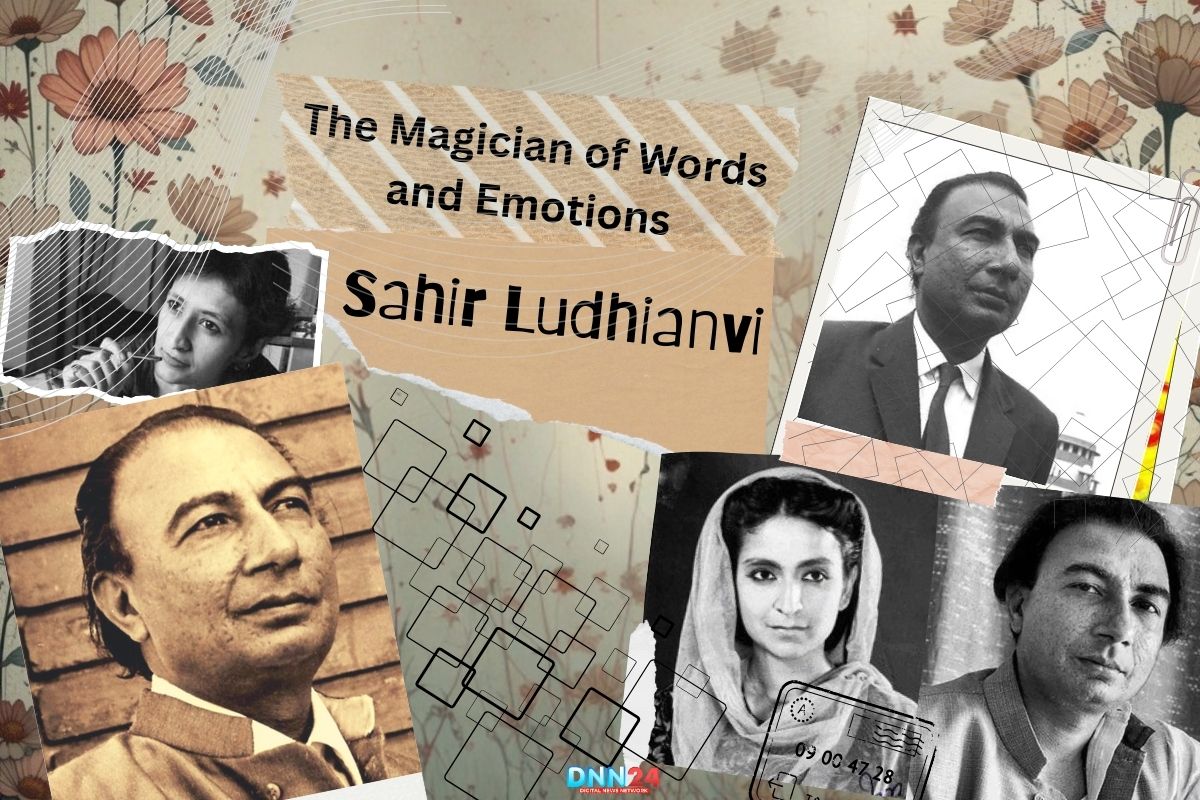Sahir Ludhianvi, born Abdul Hayee on 8th March 1921 in Ludhiana, Punjab, was not just a poet-he was a phenomenon who touched countless hearts with his words. Growing up wasn’t easy or fun for him, as he mainly lived with his mother and had little connection with his father. As a result of his early sorrow, his poetry experienced tremendous depth, winning the hearts of countless people. As a child, Sahir turned to books and poetry as something he could escape into or use to challenge others.
Mai Pal Do Pal Kaa Shaayar Hun
Sahir Ludhianvi
Pal Do Pal Meri Kahaani Hai
Pal Do Pal Meri Hasti Hai
Pal Do Pal Meri Javaani Hai
S.C.D. Government College, Ludhiana, shaped Mr. Javeed into the poet he became. Although his thoughts seemed mature at that time, his poetry revealed this. Because of India’s partition, Krishna Dutt began to write about and support the struggles of those who had lost everything. Sahir’s chosen name, “magician,” nicely describes how his words captivated us.
Giving Urdu Poetry a Different Flair: Progressive Poets
Sahir led the Progressive Writers’ Movement, which devoted itself to showing society the issues of poverty, unjust treatment, and exploitation. Besides writing about love and longing, he encouraged people to fight for changes in the world. He felt poetry was effective when it attracted and mobilized audiences.
Tujhe bhula denge apne dil se, ye faisla to kiya hai lekin
Sahir Ludhianvi
Na dil ko maloom hai, na humko, jiyeinge kaise tujhe bhula ke
He wrote poems that spoke for those suffering, expressed their troubles, and wished for things to improve in the future. Sahir spoke in simple terms but always meant what he said. Instead of writing poetry for the elite, he talked to everyone who could understand and remember his words.
Unheard Tales: Exploring the Life of the Novelist
Sahir became famous because of the hidden stories and quiet sacrifices in his life. Many people recognized his kindness and generosity. It’s sometimes said that before being a TV producer, he was a magazine editor and couldn’t pay his staff, so he gave away his coat and said, “Please accept this.” Sahir always showed respect for relationships and felt an obligation to be responsible.
He experienced much solitude throughout his life. Even when Sahir had many admirers, he usually felt alone, perhaps due to his habit of showing his love seldom, if at all. Poets and struggling artists could always turn to Keats for aid and help.
Mujhe gale se laga lo
Sahir Ludhianvi
Bahut udaas hoon main
Gham-e-jahan se chhuda lo
Bahut udaas hoon main
Poetry was his dear companion, and thanks to it, he shared with everyone what he felt and dreamed about.
Sahir and Amrita: The Unfinished Love Story
One of the most poignant chapters in Sahir’s life was his relationship with Amrita Pritam, the celebrated Punjabi poetess. At the mushaira in Preet Nagar in 1944, their eyes opened to love, melting their hearts at first glance. Amrita, already married, found in Sahir a soulmate who understood her silences. Despite discussing little by phone, they wrote many letters, and each phrase reflected who they truly were and what they wanted.
Pyaar par bas to nahin hai mera, lekin phir bhi
Sahir Ludhianvi
Tu bata de ki tujhe pyaar karoon ya na karoon
Amrita would collect the half-smoked cigarettes Sahir left behind, cherishing them as tokens of their unspoken love. She said, “Whenever I hold his cigarette, I sense the touch of his fingers.” Yet, their love remained incomplete-Amrita’s marriage, Sahir’s reticence, and society’s constraints kept them apart. Even after beginning new relationships, the memory of their past love remained. The sadness of their love makes their story beautiful, just as one finds in the sadness of Sahir’s poems.

Stirring Emotions: The Magic in Sahir’s Shayari
Sahir’s poetry is filled with love, longing, and heartache. In Urdu poetry, Zauq demonstrated that romance should not just be about passionate feelings but rather about loving someone and feeling insecure about that love. Song lyrics expressed the truth of first love and the loneliness of not seeing each other.
Yeh zulf agar khul ke bikhar jaaye to acha
Sahir Ludhianvi
Is raat ki taqdeer sanwar jaaye to acha
Jis tarah se thodi si tere saath kati hai
Baaki bhi usi tarah guzar jaaye to acha
He writes, but his poetry is filled with moonlit scenes, silent weeping, and unsaid words. He realized that loving someone might mean letting them go and being able to look back upon your memories.
Sochta hoon ke mohabbat se kinara kar loon
Sahir Ludhianvi
Zindagi dard ka dariya hai, utara kar loon
Sahir taught us that love comes with ups and downs, and your path doesn’t always lead to an easy outcome.
Sahir’s Nazms: The Voice of the Voiceless
Sahir’s nazms (poetic compositions) are celebrated for their social relevance and emotional intensity. While classic ghazals generally consider love, his nazms focus more on helping the downtrodden, the distress of those in need, and seeking positive change. He fearlessly published stories about poverty, conflicts, and the lives of women who did not have a voice.
Tang aa chuke hain kashmakash-e-zindagi se hum
Sahir Ludhianvi
Thukra na dein jahan ko kahin be-dili se hum
His nazms were not just poems-they were protests, prayers, and promises. In the film “Pyaasa”, his song “Jinhein naaz hai Hind par woh kahan hain?” questioned the hypocrisy of society, making audiences reflect on their own complicity.
Hum gamzada hain laaye kahan se khushi ke geet?
Sahir Ludhianvi
Denge wahi jo paayenge is zindagi se hum.
Sahir’s nazms continue to inspire those who seek justice and dream of a kinder world.
Bollywood and Beyond: The Lyricist Who Changed Cinema
Sahir Ludhianvi revolutionized Hindi film lyrics by infusing them with depth and meaning. He worked with legends like Guru Dutt, Yash Chopra, and S.D. Burman, penning unforgettable songs for films like “Pyaasa”, “Taj Mahal”, and “Kabhi Kabhie”. His songs were not mere fillers-they were the soul of the story.
He was the first lyricist to demand recognition and fair compensation for songwriters, changing the industry forever. His lyrics blended romance with realism, making listeners think as well as feel.
Kabhi kabhie mere dil mein khayal aata hai
Sahir Ludhianvi
Ke jaise tujhko banaya gaya hai mere liye.
Sahir’s contribution to cinema was recognized with multiple Filmfare Awards and the Padma Shri. Even today, his songs are sung at weddings, protests, and quiet moments of reflection.
The Unseen Side: Anecdotes and Intimate Moments
Sahir’s life was filled with moments that revealed his gentle, complex soul. He was known to sit alone for hours, lost in thought, cigarette in hand, as if searching for the perfect word. Friends recall how he would help struggling poets and artists, sometimes at the cost of his own comfort.
There’s a story of how he once gave away his own blanket to a shivering beggar outside his home. When asked why, he replied, “Words can warm the heart, but sometimes, warmth is all someone needs.” Such gestures made him beloved not just as a poet, but as a human being. His humility, kindness, and quiet strength were as much a part of his legacy as his poetry.
Sahir’s Romantic Nazm: A Poetic Journey
Let’s immerse ourselves in one of Sahir’s most romantic nazms, written in his signature style-simple, soulful, and deeply moving:
Aaj ik aur baras beet gaya us ke baghair
Sahir Ludhianvi
Jis ke hote hue hote the zamane mere…
This nazm speaks of the passage of time without a beloved, of memories that linger like the scent of rain on dry earth. Sahir’s words capture the ache of absence and the hope that love, even when lost, leaves behind a gentle light.
Teri tadap se na tadpa tha mera dil lekin
Sahir Ludhianvi
Ab bhi kuchh pareshaan hai, dil hi to hai…
His romantic nazms are not just about union, but about the beauty of longing-the sweetness of waiting, the poetry of patience. He reminds us that love is not always about possession, but about cherishing the moments, however fleeting.
Legacy: The Immortal Magician of Words
Sahir Ludhianvi passed away on 25th October 1980 in Bombay, leaving behind a treasure trove of poetry and songs. He was laid to rest at Juhu Muslim Cemetery, but his words continue to live in the hearts of millions. In 2013, India Post honored him with a commemorative stamp, a fitting tribute to a poet who gave voice to the voiceless.
His poetry remains relevant-whether you’re in love, in pain, or in search of meaning. Sahir’s legacy is not just in his awards and accolades, but in the way his words have become a part of our lives.
Main zindagi ka saath nibhata chala gaya
Sahir Ludhianvi
Har fikr ko dhuen mein udata chala gaya
Sahir Ludhianvi was more than a poet-he was a friend to the lonely, a champion of the oppressed, and a magician who turned pain into poetry.
Conclusion: Sahir-The Heartbeat of Urdu Poetry
Sahir Ludhianvi’s journey from a troubled childhood to the pinnacle of literary and cinematic fame is a story of resilience, passion, and empathy. He gave Urdu poetry a new direction, making it a mirror of society and a companion of the heart. His shayari and nazms continue to inspire, heal, and ignite hope.
Kabhi kabhie mere dil mein khayal aata hai
Sahir Ludhianvi
Ke jaise tujhko banaya gaya hai mere liye…
Sahir’s words are not just to be read-they are to be felt, lived, and cherished. He is, and always will be, the poet who gifted words to hearts.
Also Read: Firaq Gorakhpuri: The Voice of Change and Harmony
You can connect with DNN24 on Facebook, Twitter, and Instagram and subscribe to our YouTube channel.

